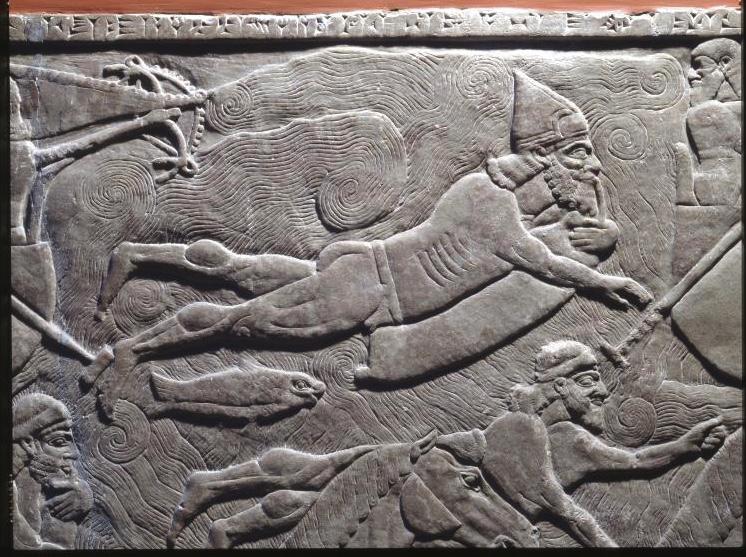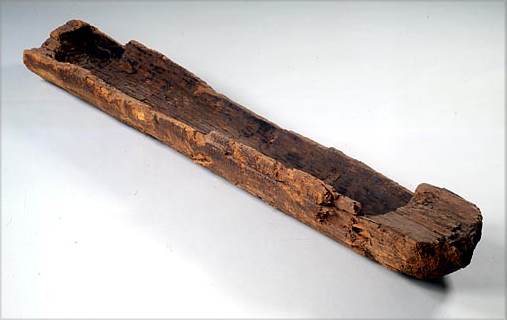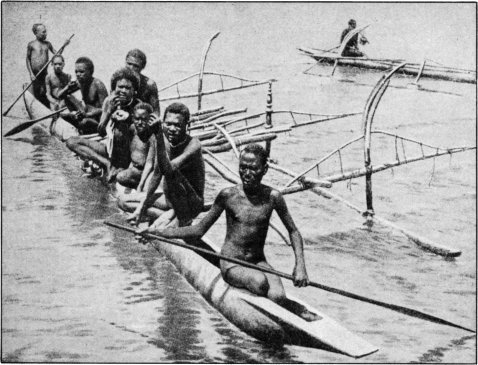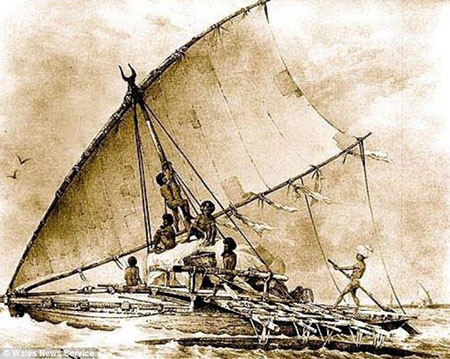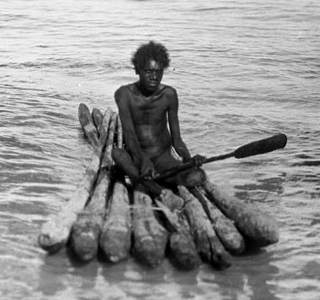
National Museum of Australia |
History of Ships Prehistoric Craft Jean Vaucher (April 2014) - updated January 2023 - |

This section covers watercraft used by early Man before the start of recorded history.
When were the first "boats" built?
The oldest boat discovered so far is the 3 meter long Pesse canoe constructed around 8,000 BCE [ Wikipedia ]; but other craft existed even earlier. A rock carving in Azerbaijan dating from ~10,000 BCE shows a reed boat manned by about 20 paddlers. In Northern Europe, some argue that hide boats (kayaks) were used as early as 9,500 BCE.
However, the very first sea-worthy boats were most probably built long before that; not by Man but by predecessors (Hominins) in our evolutionary line. Homo erectus appears to have been our first raft builder, reaching a remote Indonesian Island around 800,000 BCE, using bamboo rafts like the one shown below.

Torres Strait islanders on a bamboo raft, 1906
Encyclopedia of New Zeland
More information Homo erectus
Homo sapiens undoubtedly improved upon the crude rafts of Homo erectus. On this page, we consider boats which existed before metal tools were developped and cities arose. More specifically, before wood planks allowed the construction of large ships for war and commerce around 3,000 BCE.
Evidence of the nature of these early boats comes from unearthed remains, petroglyphs and drawings - starting around 10,000 BCE (12 Kya). To this we can add boats that are in use today but could have been constructed with stone-age tools. Boats types fall into several categories depending on the materials and tools used in their construction:
- Rafts using bamboo, logs or reeds
- Dug-out canoes
- Skin boats using leather or bark over a wood frame
Prehistoric Rafts
Anything that floats can be lashed together to make a raft and serve as a boat. Only primitive cutting tools are required. Bamboo, wood logs and reeds have all been used as raw materials, tied together with vines or palm fibers. Early rafts served as fishing platforms, allowed transportation across bodies of water and even formed floating islands for villages.Raft propulsion is achieved by pushing with poles, pulling with ropes or paddling. When floating down rivers, the current does all the work. Later, sails will be added to reduce effort going downwind; but rafts have no keel or shape to keep them moving in a straight line, so steering is always difficult.
Nothing remains of these early boats - which have long since rotted away - but watercraft still in use today in remote areas provide examples of what early boats must have looked like.
| Below, click on images to enlarge! Use the arrows to move to new images. |

Primitive Log Raft |

First Mariners Project Flores to Timor on Hominid Raft |
| In some areas, the primitive log raft evolved into more elaborate versions with a tapered shape and an odd number of curved logs often held together with sharpened hardwood pins. Examples below are from India (around Chennai) and medieval Japan. | |

Tamil Boat, Kattumaram (India) |
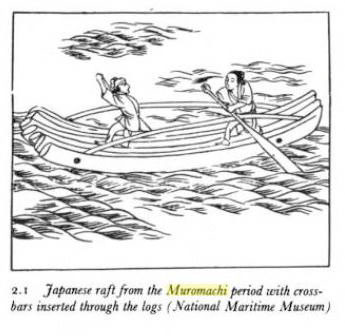
|
| Primitive rafts with modern materials | |

Boy on styrofoam raft in Manila Bay Guardian |
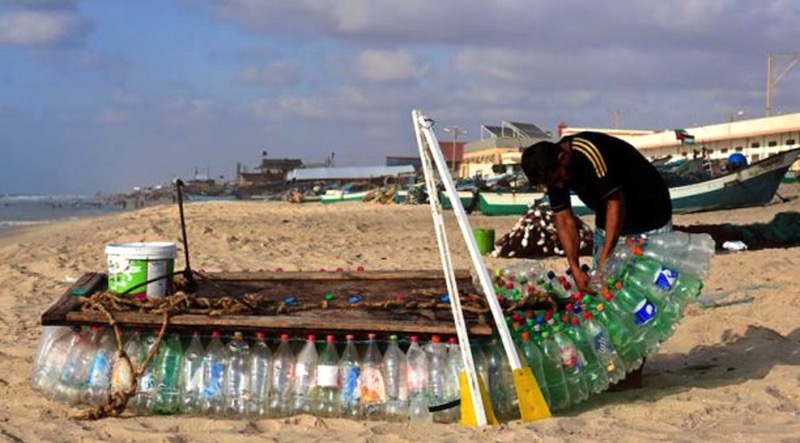
Gaza fisherman floating on 700 plastic bottles Times of Israel (Aug 2018) |
|
Kon-Tiki Raft
Thor Heyerdahl (1947) In 1947, a Norwegian expedition sailed 4300 miles accross the Pacific on a Balsa log raft built with primitive materials and techniques, showing that ancient craft were capable of long distance ocean crossings.
More information on Modern Crossings Page
|

Kon-Tiki, Balsa Logs and Sail |
Bamboo Rafts
Bamboo rafts, little changed from the Homo erectus model, are still in wide use in Asia. But now, synthetic ropes are used and the ends are often curled up by steam. The rafts are used for fishing, ferrying and, more recently, "Ecotourism".

Typical rafts with curved ends |

Cormorant Fishing (China) |

Ferry in Kerala |

Ecotourism in Jamaica |
Image Credits
Reed Boats
Reed boats are made by assembling bundles of reeds (or other thin branches), into pointy kayak-like shapes. They were used in areas where wood was scarce, like Egypt and Iraq, before efficient wood-working tools were developped. Petroglyphs from the Mesolithic period (Azerbaijan, 12,000 - 7,000 BCE) show large reed boats and remains of a 7000 year old reed boat were found in Kuwait.Nowadays, the most primitive examples are the one-man boats made from banana stalks used on Lake Baringo. The most complex are found on Lake Titicaca on the border of Peru and Bolivia. Here large boats made up of millions of Totora reeds can support as many as 60 people. Reed boats are still used in Peru and Ethiopia.
Inflated Animal Skins
Dugout Canoes
Dugout canoes require more advanced tools, like axes, adzes and chisels, initially made from flint then metal. Fire can also serve to hollow out the core. Suitable tools appear around 12,000 years ago (Mesolithic period) and one can assume that canoes of some form would be developped shortly therafter; but more precise chronology must rely on the discovery of datable artefacts. The oldest boat found so far is the 3 meter wood canoe shown below, constructed around 8,000 BCE [ Wikipedia ]. The next oldest is the 8 meter Dafuna canoe (6,500 BCE, Northern Nigeria).Dugout canoes in various forms were developped all over the world wherever large trees grew. Later designs added outriggers to help with stability and eventually sails.
| Remember... Click on images to ZOOM! ; arrows to change; ESC to quit ! |
Sources
- Pacific Northwest Canoes, Simon Fraser University

- A briefe and true report of the new found land of Virginia (1585)...makinge their boates

Coracles and Kayaks
The next innovation in watercraft was putting a waterproof skin over a rigid frame. This made for a lighter boat, portable even! There is (circumstantial) evidence that such boats were used as early as 9,500 BCE - before the Pesse canoe; but the required technology is more advanced and it is probable that wood canoes came first.Coracles use wicker baskets for the frame. European coracles have leather as a skin. In the Middle East and Asia, the waterproofing is achieved with cloth and pitch; for example in the Bible, Moses is sent off in a small basket of bulrushes coated in pitch.

Indian Coracle |

Irish Curragh |
In North America, Indians developped the birchbark canoe: a frame of wooden ribs covered with sewn patches of bark. Birchbark was the perfect choice, not only was it lightweight and smooth, but it was also waterproof and resilient. The joints of the canoes were bound together by the root of the white pine and then made waterproof by applying hot pine or spruce resin. [ Ref. ]
The Kayak is a traditional boat made by stretching seal skins over a framework of light driftwood or whalebone and then coating it with whale fat. They were developped by the indigenous Aleut and Inuit in subarctic regions of the world. Typically, the kayak is covered and includes a spray skirt to insulate the the rider from the cold and prevent the boat from being swamped by waves. The northern peoples also built Umiaks: larger open seal-skin boats used to move people and possessions to seasonal hunting grounds. [ Wikipedia ]

Algonquin Birchbark Canoe (R. Griffing) |

Seal Skin Kayak |
Sources
European Leather Boats
The argument for prehistoric European leather-boats comes from the discovery, in northern Germany, of reindeer bones (dated around 9,500 BCE) which show arrow wounds from behind in the neck and shoulders. This is indicative of a hunting technique still used - until recently - by Inuits in North America. As shown below, the hunters ambush migrating herds from boats as they swim accross lakes or rivers. The lack of trees in northern Europe at that time, precludes the use of dugout canoes; hence the assumption that (reindeer) hide boats were used. [Ref. Europe's First Boats, P. Fletcher, AAPP, vol. 93, no. 2 (2015) ]

Eskimaux killing deer on a lake (1824) Courtesy of the John Carter Brown Museum ( CLICK for larger view! ) |
The Next Step: Planks
The next quantum leap in boat design would occur with the Metal Age around 3000 BCE. Metal tools allow the efficient transformation of trees into planks making possible the construction of larger ships for war and commerce by the Egyptians, Phoenicians and Greeks.
| Note:
The content of this page is not original. It is an edited digest of the best that I could find on the Internet as I researched various topics over the years and looked at hundreds of sites. As a result, I have lost track of where I found what. If I have used some images that you own without sufficient credit, contact me and I will either remove them or add a reference that you are happy with. |








